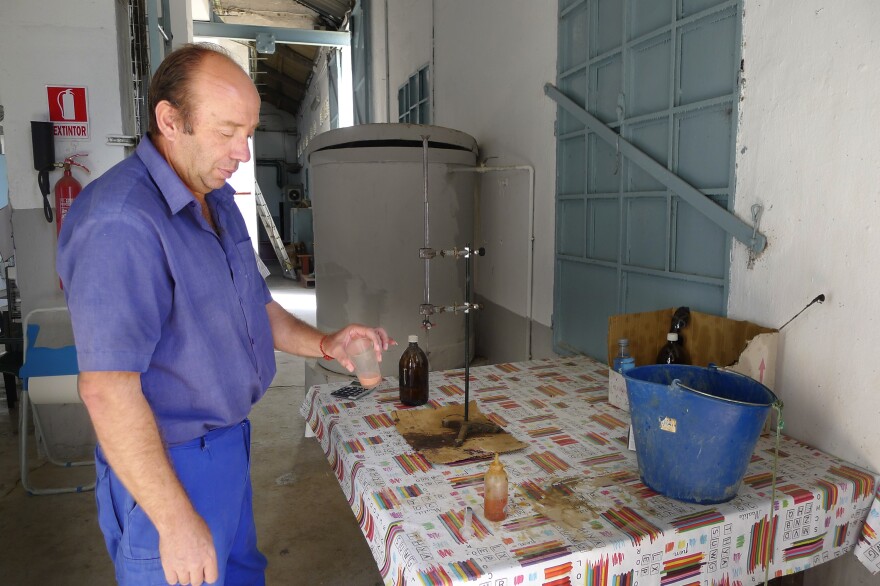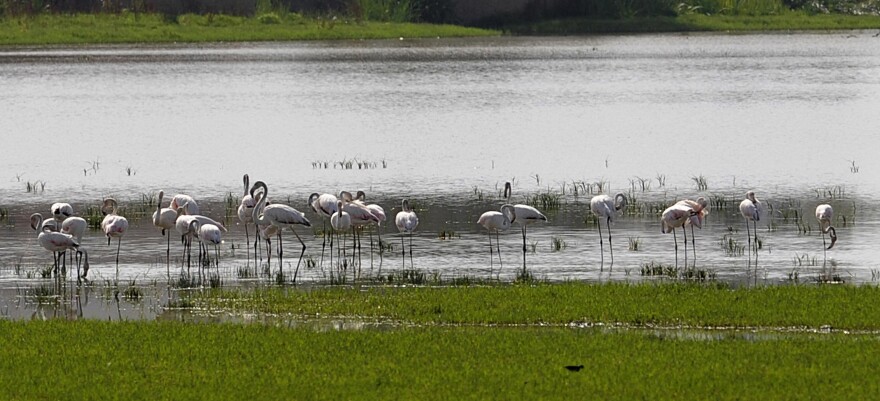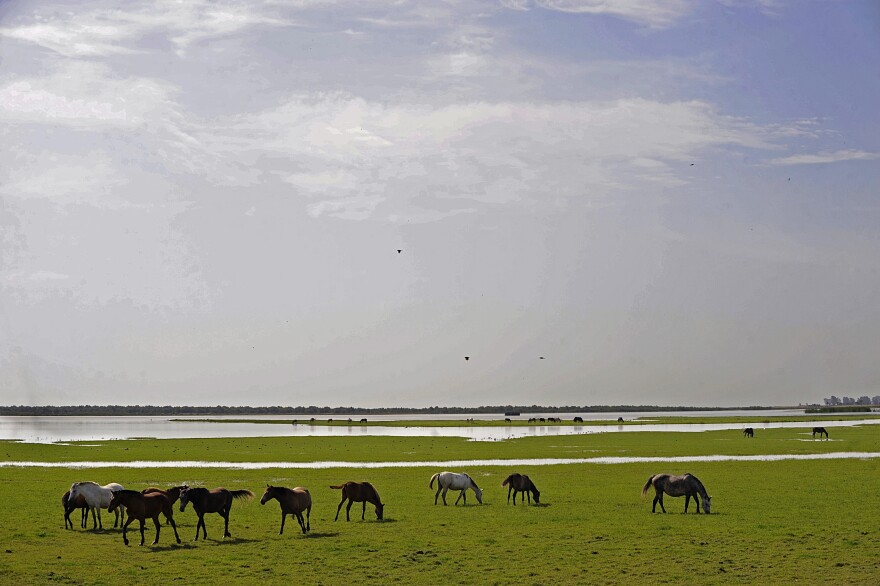Wild horses and cattle graze on the marshy banks of southern Spain's mighty Guadalquivir River.
From the mouth of this river, Christopher Columbus set off for the New World.
But since then, the river has gotten more salty. As fresh water is extracted for agriculture, drought — made more frequent by climate change — means less rainfall replaces it. Tides send salt water farther upriver.
Inside a cement building straddling part of the river, pumps suck 800 gallons out of the Guadalquivir per second — diverting it to irrigation canals.

"Depending on how many grams of sodium chloride [salt] are in the water, it can do real damage to crops in the area," says José Godoy, who works at the pumping station. "We test the water every hour. We have to be vigilant. When the salt level rises, we have to cut off flow to the canals."
Either crops die of salt poisoning — or the water is cut off and they die of drought.
That's happened at least three times in the past two decades. Whole harvests have been lost, when there isn't enough fresh water to irrigate.
"We have to care for the environment, but we also have a right to make a living," says rice farmer Manolo Cano Lopez, looking out across his rice paddies. "When I was a kid, people lived here without running water or electricity. I want a certain standard of living for my children, without damaging the environment."
But making a living without damaging the environment is getting harder on the Guadalquivir River delta. Locals note weather patterns have changed.
"The rain comes less often, but when it does, there are violent storms!" Cano says. "It's damaging my crops. They're like my babies, these delicate rice plants."

This summer, an early heatwave sparked wildfires much earlier than normal, in both Spain and Portugal. More than 60 people died in one fire in central Portugal, ignited by dry lightning.
This is what scientists say farmers and residents can expect from a warming planet. Already-fragile ecosystems like the Guadalquivir delta are where climate change could have the most deadly impact.
Scientists predict all of southern Spain, with its varied landscapes — arid Mediterranean terraces, partial deserts and delicate wetlands — will be reduced to one big desert by the end of this century, if current rates of greenhouse gas emissions continue unchecked. Manmade water shortages are already compounding those effects.
The Guadalquivir delta is Spain's biggest rice-growing area. (It used to be Valencia, the famous homeland of Spanish paella. But during the Spanish Civil War in the late 1930s, when Valencia fell to Republican forces, the military dictator Francisco Franco ordered that rice be planted on the Guadalquivir delta, which his Nationalist forces still controlled. Acreage of rice farms in the area has expanded ever since.)
It may sound strange to grow rice — which grows best submerged in water — in such a hot, dry climate. While reporting on the delta in June, daytime temperatures hovered around 104F. Farm workers start their days 4 a.m., in order to finish by noon, before it gets too hot. It's a severe climate — and it's forecast to get worse.
But rice is not the biggest offender to the environment here, because rice farmers draw water from the river, extractions from which are regulated. The bigger problem is berries. The Guadalquivir region supplies about a third of all of Europe's strawberries — and strawberry farmers drill wells into the aquifer.
"The problem with the aquifer is that it's something you don't see, because it's an underground pool," says Felipe Fuentelsaz, who tests groundwater levels for the local branch of the World Wildlife Fund.
Eighty percent of the region's aquifer has dried up because of intensive agriculture and the drilling of illegal wells, the WWF says. Some farmers rent drilling rigs and haul them out into secluded forests in the middle of the night, or on holiday weekends, to drill wells for which they don't have permits. The WWF estimates there are at least 10,000 illegal wells in the entire region, and it contends that local officials aren't doing enough to stop them.

Local officials said they closed about 300 illegal wells last year.
Following GPS coordinates provided by the WWF, NPR was able to locate a secret reservoir hidden in the forest, where farmers store the water they've sucked out of the aquifer illegally. It's a huge turquoise blue pool, about half a football field wide, and perhaps just as deep, with more than a dozen pipes spewing water into it, apparently from illegal wells scattered across the area.
This isn't only about farmers stealing water. It's about farmers stealing water that won't be replenished as quickly by rainfall, because of increasing drought. Climate change is already driving up local temperatures, experts say.
"At the moment, they are increasing 0.07 degrees [Celsius] every year. So it's something that's really high," the WWF's Fuentelsaz says. "The normal seasons have been moved. This is really a complete change for biodiversity — for flora, for fauna, for everything."
And the Guadalquivir delta has some of the most varied flora and fauna in Europe. Alongside miles and miles of big industrial commercial farms, the delta is also home to Doñana National Park, a UNESCO World Heritage Site famous for its biodiversity — with wild horses, pink flamingos and six million migratory birds. Water shortages — from over-farming and from climate change — affect them, too.
Last year, UNESCO threatened to put Doñana on its "Danger List" of World Heritage Sites where wildlife or conservation are at risk. The Florida Everglades has also appeared on the list. Doñana would be the first national park in the European Union to make the list. In its warning, UNESCO cited all the illegal wells in the area. As farmers drain the aquifer under the Guadalquivir delta, lagoons shrink in the national park next door.
"Look at all the ducks, flamingos — so many species of birds in this one lagoon alone!" says Doñana's director, Juan Pedro Castellano, during a tour of the park. "It's just like climate change — we don't know exactly what will happen and how fast. But where we'll see change is in these lagoons and wetlands right here."
Man-made water shortages, the park director says, are essentially giving us a preview of how this whole region will experience climate change. Scientists predict rising temperatures will dry out this area.

"If the aquifer is drained, this area gets dominated more and more by desert plants," Castellano says. "It reduces the biodiversity in this sandy part of the park."
Castellano disputes assessments by UNESCO and the WWF that Doñana might be in danger. He says his efforts at conservation have been successful, and that he's working with local officials in nearby towns to discourage the drilling of illegal wells by farmers.
UNESCO's 21-member World Heritage Committee is meeting July 2-12 in Krakow, Poland, where it will review Doñana's conservation and decide whether to classify it as endangered.
For the rice farmer Manolo Cano, the seasons have already changed. Spring seems to come earlier every year, he says. None of his children has taken up the family business. He wonders what it must have been like 500 years ago, when Christopher Columbus sailed through the Guadalquivir River, right next to where his rice paddies now are.
"They must have been able to water their crops as much as they wanted, and never worry," he laments. "Nowadays, we farm so much, we take too much water out of the river."
Cano sighs and kicks at some weeds alongside one of his rice paddies. It's an invasive plant, not native to the area. He thinks the seeds were probably carried in on a truck of gravel from another province or country. He describes waking up at 4 a.m. to come out here and yank the tough stems out of the ground.
"It's the price we pay for modernity," Cano says. "We have to grow food. But to do it, we've changed this landscape forever."
Copyright 2023 NPR. To see more, visit https://www.npr.org.





